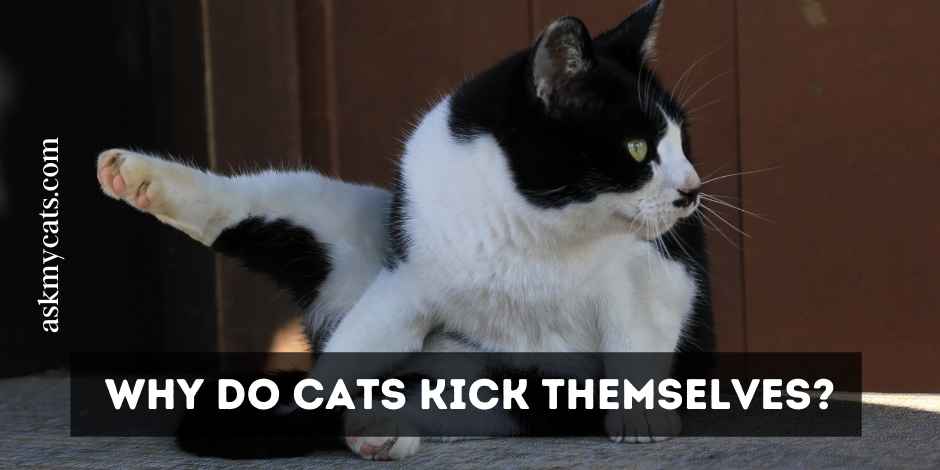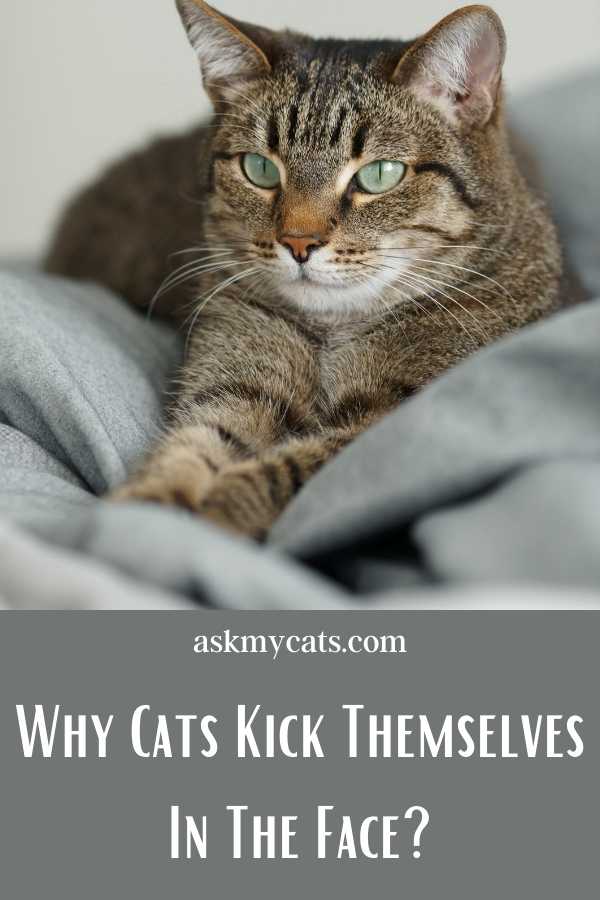The reason I adore cats so much is because of their odd and erratic behaviour. Any of the moves that cats do are unique and have never been seen in any other breed.
This is what makes them so enjoyable to be around and why, even after years of living together, they can still impress you.
Cats often kick themselves in the face because they are in a good mood and want to play with you.
Kicking oneself is one of the unusual habits that cats have. The ‘bunny kick’ is a term used by the feline culture to describe this action.
When you reach out to pet or play with your cat, she turns over onto her stomach, coils her legs around your arms, and tries to kick you with her hind legs.
It’s not life-threatening, but if you don’t understand why it happens and how to stop it, you might end up scratched and wounded.


Give Your Cat the Perfect Day
Get the Free Ebook!
Why Cats Kick Themselves In The Face?
The bunny-kicking behaviour can seem unusual at first, but there are a few possible reasons.
Either your cat kicks with her hind legs as a playful behaviour, equivalent to dog wrestling, or she kicks with her hind legs for one of two reasons.
Or she’s attempting to be protective and fight because she really needs to be alone.
The explanation for this action is determined by the conditions. You’ll need to read a little bit about how to say what’s causing your cat to behave this way in any particular case if you want to find out why she’s doing it.
Although playtime kicks are common when your cat gets a little too excited, the defensive kick is something you want to stop.

1. Playtime Type Of Kicks
When your cat is playing with you, she can turn over on her back, grab your hands, and kick them with her paws.
When parent cats interact with their kittens, they exhibit this behaviour.
Even if your cat’s kicking is coming from a nice place and all it wants to do is play, it can get a little awkward if it gets out of hand.
It’s in your cat’s DNA to continue to bring out the prey that’s attempting to escape.
This is why, if she gets carried away, her impulses can drive her to do more intense hind leg kicks or even start acting aggressively defensively.
Cats do the same playful bunny kick when they’re playing with animals, which are usually wide and fuzzy.
If you look for it, you’ll find that there are also toys built specially for this form of play.
Those toys are commonly referred to as kick-bags, and they resemble a long tunnel filled with your favourite catnip stuffing.
Also if you know your pet will never hurt you, don’t use your hands as toys in these cases.
It’s not a smart idea to promote this activity because you could inadvertently teach your cat that scratching or biting you is appropriate.
When playing, your cat can never growl, hiss, or yell. That’s a symbol of hostility. That’s when you’ll know your cat isn’t messing around, whether it’s with you or another cat.
2. Defensive Type Kicks
When a cat is going to be attacked or is already being attacked, she will turn onto her back to defend herself. The more serious explanation for the bunny-kick is this.
Your cat will catch her adversary with her forelimbs in a real battle and knock them in the bare belly. Cats are fast creatures that don’t want to compete for long periods of time.
Instead, they attempt to finish the game immediately with a powerful kick that forces the opponent to run.
Unlike the fun bunny blow, this is a serious way for your cat to express her disinterest in playing or interacting with you.
It usually occurs shortly after you begin petting your cat. She can attempt to signal you in other ways before doing the bunny kick, such as moving forward, meowing, or nipping your fingers.
What Is A Cat Bunny Kick?
When you see a bunny kick, usually during playtime, you’ll know what it is. Your fuzzy buddy will loop their front two legs around the intended target (say, your arm) and kick at the target with their hind legs, like a little thumper.
When cats engage in defensive play or harass their prey, they usually do this bunny-kick action (i.e., your arm).
Cats are masters of body contortion, whether jumping from elevated ledges or curling up into small spaces. The cat bunny hop, as they kick their hind legs at you, a treat, or another cat, is a rare action you might have seen.
What triggers cats to bunny kick? That’s for more reasons than just showing off their martial arts skills.
Why Do Cats Bunny Kick?

A bunny kick may seem adorable, but it is a sneaky and potentially risky action.
The cat bunny kick is a tactical self-defense and hunting move that can be done by a domestic cat wandering the rooms of a house or a large cat prowling the woods.
When a cat is lying on its back with all four paws and claws exposed — whether in play or in real life — their adversary has no chance.
Cats in the wild use the bunny kick to grab their prey seconds before killing it.
You might note this action if you’ve ever seen a house cat capture a mouse or pigeon, but the cat doesn’t always kill the rodent, especially if it’s not hungry.
Cats can throw the prey around in their paws for a while in addition to bunny-kicking.
The bunny kick is an offensive move, even though you and your feline partner are joking around.
Cats are also good at deceiving their opponents into believing they’re docile, particularly when their bellies are exposed.
Your kitty could look at you as if to say, “Don’t you want to massage my soft belly?” and, in many cases, they do. If they’re feeling particularly feisty, though, they’ll grab your hand the moment you brush their furry hair.
Can I Anticipate A Bunny Kick?
Understanding animal actions as a pet parent is one way to know if the cat is relaxed or attacking. Your pet is able to rumble if their ears are flattened against their head and their eyes are dilated.
The more time you spend with your cat, the more you’ll learn about their preferences. Some cats dislike having their abdomens rubbed at all, and if you want to massage them there, they will get enraged easily.
A belly massage becomes an assault all of a sudden. When your cat is upset, they won’t hesitate to tell you.
How To Avoid Your Cat From Kicking?

Petting cats on the stomach is what usually sets them off. Cats despise getting their stomachs prodded.
Not until they’ve absolutely revealed it in your presence while you’re napping.
Regardless of how much she loves and trusts you, rubbing your cat on the stomach may induce an immediate protective response.
To stop this kind of action, avoid petting your cat on the stomach and cuddle her in a more secure location.
To begin, remember that your cat is not attempting to hurt you when they use the bunny kick during playtime; but, even in moments of calm, you can be scratched and/or bitten.
Second, the cat’s use of a bunny kick is instinctive.
The bunny kick is rooted in a cat’s hunting instinct, and you can’t avoid it because it’s part of that instinct. But there’s good news: you should reroute it.
According to International Cat Care, “only the greatest hunters were able to live and breed up until this point in time, suggesting that our pet cats today are inherited from the most adept hunters.”
Avoiding rough play for your pet is one way to keep bunny kicks to a minimum. Roughhousing, such as chewing on your hand or shoulder, is not a smart idea because it promotes aggressive action.
Another way to deter cat violence is to give the cat a stuffed toy to stalk and harass (with or without catnip).
Cat bunny kicks can be all fun and games before you get bitten while hanging out with your feline companion.
To hold the cat antics to a low, indulge in positive playtime with food puzzles or cardboard boxes.
Cat Kicking As A Reflex Action
Cats knock themselves in the face as a reflex, which is one of the causes.
Tell the cats are on their side when they bend themselves in a certain direction.
They set off this reaction by kicking themselves in the face uncontrollably.
It’s for this cause that cats often have to bite themselves to overcome their nerve impulses warning them to avoid kicking.
This is equivalent to someone who begins twitching out of nowhere and can only be shaken out of it by pinching themselves.
Why Does My Cat Kick Her Back Legs?

When cats engage in play actions such as wrestling, they can kick with their hind legs.
When cats are fighting or feeling territorial, they’ll behave this way to force the other person to leave them alone.
A cat can roll onto her back whether she is going to be attacked or is currently being attacked. The cat can defend itself with all four paws in this way.
The cat can catch the attacker with its forelimbs and stomp or rake the opponent’s exposed abdomen/underbelly with its hind limb claws.
When your cat responds this way to you when you try to touch her, it’s possible she’s trying to play with you.
When you watch cats or kittens playing with each other, you’ll notice that they do the same thing, but not with the same strength as when they’re fighting.
When cats play, they usually do not injure one another. However, owing to a human’s lack of hair, a cat can unintentionally bite a person’s hand or shoulder.
Keep in mind that cats can behave similarly when they are territorial or want their owner to stop petting them.
Aggressive behaviour is described as behaviour that raises the space between you and the animal.
For example, a cat that rolls onto her back, grips your hand with her forelegs, and violently rakes her hind legs against you is definitely saying, “Stop!” Know that a cat who is rolling onto her back does not want you to stroke her belly.
Cats roll onto their backs to show that they are at ease with a human or another animal, indicating that they are not threatened. It’s best not to try to take advantage of her confidence by giving her a belly rub.
Many wild cats do not like to fight for long stretches of time; instead, they choose a swift attack or defensive action to cause damage or damage to the other party, forcing the other animal to run.
Frequently Asked Questions
Why does my cat kick himself with his back legs?
Cats will also throw out their back legs to partake in play behaviours such as boxing. When they’re fighting or feeling territorial, they’ll behave this way to force the other person to leave them alone. A cat can roll onto her back whether she is going to be attacked or is currently being attacked.
Why do cats bite and bunny kick?
Kittens’ typical play activities include chewing and bunny-kicking. This is how they interact with each other and their mother. The game simulates how cats can pounce on, capture, and bite prey in the future. When littermates play together, they show each other how to softly use their teeth to manage their bite.
Why do cats attack their own feet?
Stress is the most common cause of compulsive behaviours in cats, particularly when they are torn between two competing courses of action. Or, as part of “Rolling Skin Syndrome,” or feline hyperesthesia, they can bite their own tails or claw at their own faces.
Final Words
As it turned out, no one has ever looked at it in depth. The most famous hypothesis is that it is both a defence and a hunting mechanism.
If the cat tracked down and caught a bigger piece of prey that it couldn’t subdue with its teeth alone, the plan is for it to pin the prey to its chest with its front paws and bicycle kick it with its back feet, clawing at and potentially disembowelling the prey.
The cat may be overpowered by a larger animal in a defensive position, in which case the kicking device may be used to free itself and gain some distance from the intruder.
Let us know in the comments section below if you have a cat that is kicking them every now and then!
